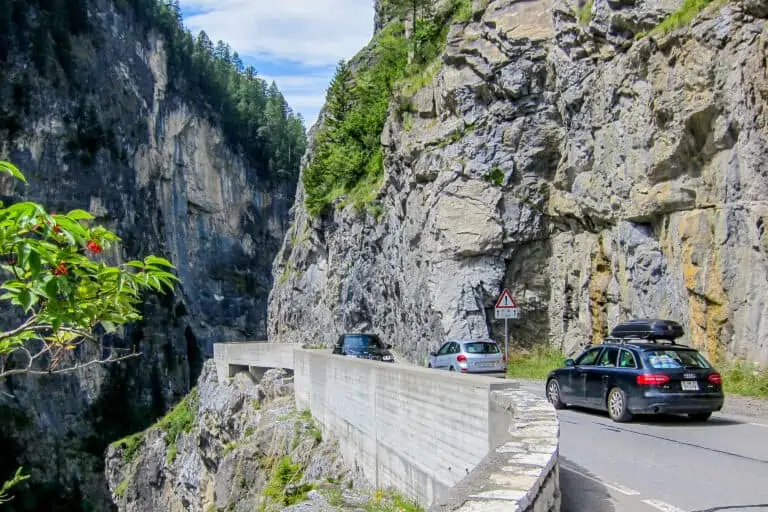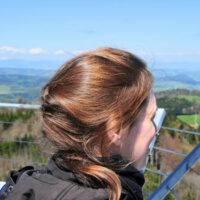Prepare for your mountain trip
Learn about the route you’ve planned
- Many road passes close for winter. In some cases, you can use car trains instead.
- Some passes are too narrow or steep for trailers and mobile homes.
- Study road conditions and possible closures each day before starting your trip.
- Estimated driving times by navigation systems and route planners are often quite optimistic. Take your time.
Know the rules
Apart from the rules for mountain roads explained here, study the general Swiss traffic regulations too. Make sure you have the required equipment.
Prepare your car
- Your car should be in excellent condition. The required official periodic inspections must have been done. Double-check essentials such as the breaks and tyres yourself.
- Even if you know your car well, always have its manual at hand.
- Make sure that you have enough gas to make it to the next village, as there are no gas stations on Swiss pass roads.
Focus on the road, not the route: use a navigation system
You need full attention when driving Swiss pass roads. A navigation system helps you with that. If you use a navigation app: pick one with offline maps, so that network availability and bandwidth limits are no problem. Also use a cellphone holder.
Stick to these priority rules on mountain roads
These priority rules are important on Swiss pass roads:
- Ascending traffic has priority over descending traffic, because descending vehicles can continue more easily after coming to a full stop. So on narrow roads, descending traffic has to clear space for ascending traffic.
- Heavy vehicles have priority over light vehicles. It doesn’t matter whether they’re ascending or descending.
- A yellow Swiss Postbus always has priority, even while descending and even over other heavy vehicles. When curves are ahead, the bus may announce its presence with its characteristic horn. Stop well before the curve, because a bus in a narrow curve needs all available space.
How to handle narrow roads and curves
Mountain roads can be narrow, may have lots of sharp curves, and may pass along deep ravines. A crash barrier or fence, which is mostly present, is not always designed to actually stop a vehicle. Your view can be blocked heavily in curves with rock walls or trees along the road.
This is how to drive safely:
- Always slow down in case of a narrow passage, sharp curve, or blocked views.
- Sometimes there is a mirror to see around the corner: use it to see if there’s traffic approaching on the other lane.
- Decelerate before the curve, not when you’re already in the curve. Once in the curve, you may step on the gas a bit to improve traction.
- Be sure to keep on your own (right) lane, especially in outside curves. Some people tend to steer towards the inside of the curve, which can cause serious accidents with oncoming traffic.
Take other road users and objects into account
Beware of cyclists, hikers, cattle, and rubble:
- Be especially careful with cyclists in tunnels and don’t overtake them. There’s no room for errors in tunnels.
- Overtaking descending cyclists is usually not necessary, since they are at least as fast as cars. Keep at a safe distance.
- You may overtake ascending cyclists if you can do so safely. Keep plenty of distance and use your direction indicator.
- Drivers of slow vehicles may help you with a short signal with their right indicator to show you that you can overtake safely. You can do that yourself as well, if faster drivers are following you.
- If you need to warn following traffic, you can do so by switching on the emergency signals.
- Do not pull over in places with rubble on the road, because it indicates a risk of more rubble coming down.
- On narrow roads where you can’t see far ahead, you can warn other traffic that you’re approaching. You may honk in the daytime or use light signals at night. Excessive honking and honking in towns is not allowed.
How to behave safely in tunnels
Long tunnels are no exception in Switzerland. The longer ones are usually well-lit and equipped with emergency exits and phones. Shorter tunnels may be unlit. They can be cold and moist, so water may drop down.
Basic rules for driving in Swiss tunnels
- When entering the tunnel, take off your sunglasses and double-check if your lights are switched on. You can tune into the indicated radio channel if you like.
- Adjust your speed and never exceed the speed limit.
- Don’t overtake.
- Keep at a safe distance from the vehicle in front of you.
- Don’t ever turn or drive backward.
What to do in case of a traffic jam in the tunnel
- Keep a safe distance of at least 5 m from the vehicle in front of you.
- Turn off the engine if traffic comes to a stop.
- Keep at the (very) right side, creating space for possible emergency vehicles.
- Stay in your car.
What to do in case of a breakdown, accident, or fire in the tunnel
- Try to pull over in one of the designated areas along the road, or as close to the right wall as you can.
- Turn on your warning lights.
- Carefully leave your car, preferably wearing a warning vest.
- Contact the rescue workers. Use the designated phones rather than your mobile phone, as its signal may be poor or completely gone in a tunnel.
- If you have to, leave the tunnel using the closest emergency exit. Such exits are well-lit and indicated by signs.
- Don’t spend unnecessary time searching for your belongings. Bringing yourself and others to safety is much more important.
- Only try to extinguish a fire if it’s small and in its initial stadium. If you can’t extinguish it, leave the tunnel as soon as possible.
How to park on a slope
You can do a number of things to park safely on a slope. You definitely need to use the handbrake and shift the transmission to first gear. When the slope is very steep you may put a stone behind the wheels and turn the steering wheel. This way, the car can’t roll back too far.
How to use your transmission and brakes correctly
While ascending
- It is important to utilize the hauling capacity of the engine. This means that you do not change gears as quickly as on flat roads, in order to keep a high engine speed (3000 – 4000 revolutions/min).
- The speed of the vehicle should be relatively low for safety reasons.
- Assuming a 5-gear car, it is usually sufficient to use gears 1 to 3 only.
While descending
- You should also use a low gear and a high engine speed when descending. You can often use the same gear that was useful during the ascent. The deceleration will (partly) be done by the engine this way. It saves the brakes, which can get too warm if you use them continuously.
- If you continue to gain speed, pick a lower gear or occasionally gently use the brakes. The accelerator pedal will not be necessary during most of the descent.
- Do certainly not drive down with the transmission in neutral. In most cars with automatic transmission, you can just use the regular D-position.
- If you have automatic transmission, switching to the manual transmission mode can provide better control, as you get to pick the gear yourself.
- On slight grades, it may be necessary to pick a low gear to prevent the car from changing gears too frequently. In such cases, use position 1 or 2, or the mountain gear if available.
What to do if the engine or brakes get overheated
You need to pull over if your car indicates that the engine or brakes are too hot. An unpleasant smell may be an indication as well. If this happens you have probably used an incorrect gear. You can turn on the heating to withdraw energy from the engine. Turning off the air conditioning might help when ascending, as all energy remains available for the engine now.
What to do if the brakes fail
Acting quickly is necessary if you notice that your brakes fail:
- Try to decelerate by pulling and releasing the brakes repeatedly, or try one more pulls with hard pedal pressure.
- Only pull the handbrake if the road is not slippery. Otherwise, you will lose control of the vehicle completely.
- If necessary, change to gear 1 or 2 without shifting to neutral, hopefully causing the engine to decelerate.
- You can also turn into an ascending side road or meadow to decelerate, or scrape the car at a small angle to a (rock) wall along the road.
Other websites of interest
- www.tcs.ch: road pass information and current conditions
- www.tcs.ch / phone number 0800 140 140: roadside assistance in Switzerland
- maps.google.ch: Switzerland on Google Maps
- web.archive.org: sound of the Swiss Postbus horn








